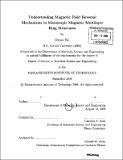Understanding magnetic field reversal mechanisms in mesoscopic magnetic multilayer ring structures
Author(s)
Ng, Bryan
DownloadFull printable version (29.08Mb)
Other Contributors
Massachusetts Institute of Technology. Dept. of Materials Science and Engineering.
Advisor
Caroline A. Ross.
Terms of use
Metadata
Show full item recordAbstract
Patterned pseudo spin-valve rings show great promise for device applications due to their non-volatility and variety of stable magnetic states. However, the magnetic reversal of these elements under an applied field is complex due to the magnetostatic coupling between the two ferromagnetic layers. Elliptical rings are electrically probed using highly symmetric Wheatstone bridges in conjunction with traditional four-point electrical measurements and micromagnetic simulations. New insight into domain wall nucleation and propagation events are elucidated. The resulting behavior is found to yield large signals at very low fields, making these devices ideal for device applications in data storage and computer logic. 360° domain walls are found to be extremely stable until fields as high as 10000e, but are positionally uncontrollable in elliptical rings. Rhombic rings were investigated as a geometry that can nucleate, propagate and pin domain walls more easily. Measurements and simulations confirm that the same reversal mechanisms exist and domain walls are more systematically positioned. The control over 3600 domain walls is valuable since reversals can occur without nucleation by decoupling the wall into a reverse domain. As a result, rhombic rings are useful as devices that can perform device functions at extremely low fields.
Description
Thesis (M. Eng.)--Massachusetts Institute of Technology, Dept. of Materials Science and Engineering, 2008. Includes bibliographical references.
Date issued
2008Department
Massachusetts Institute of Technology. Department of Materials Science and EngineeringPublisher
Massachusetts Institute of Technology
Keywords
Materials Science and Engineering.